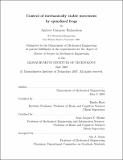| dc.contributor.advisor | Emilio Bizzi and Jean-Jacques E. Slotine. | en_US |
| dc.contributor.author | Richardson, Andrew Garmory, 1977- | en_US |
| dc.contributor.other | Massachusetts Institute of Technology. Dept. of Mechanical Engineering. | en_US |
| dc.date.accessioned | 2005-05-19T15:25:36Z | |
| dc.date.available | 2005-05-19T15:25:36Z | |
| dc.date.copyright | 2003 | en_US |
| dc.date.issued | 2003 | en_US |
| dc.identifier.uri | http://hdl.handle.net/1721.1/16954 | |
| dc.description | Thesis (S.M.)--Massachusetts Institute of Technology, Dept. of Mechanical Engineering, 2003. | en_US |
| dc.description | Includes bibliographical references (leaves 54-58). | en_US |
| dc.description | This electronic version was submitted by the student author. The certified thesis is available in the Institute Archives and Special Collections. | en_US |
| dc.description.abstract | Evidence suggests that the isolated vertebrate spinal motor system might use only a few muscle synergies for the production of a range of movements. The evolution of such synergies encoded in the spinal cord could be dictated by mechanical stability requirements for interacting with the environment or by particular performance advantages. Previous work in frogs and cats has shown that the isometric forces measured during movements evoked by intraspinal stimulation converge to a stable equilibrium. In non-isometric conditions, however, there is no guarantee that a similar property of convergence will be observed. We therefore characterized the stability properties of trajectories produced by spinalized frogs. Hindlimb movements in frogs were measured and phasic force perturbations were applied by a Phantom robot (Sensable Tech., Inc) attached at the ankle. EMGs were recorded from 12 hindlimb muscles and used to trigger the perturbations in both hindlimb-to-hindlimb wipes and withdrawals. In both behaviors, we found that the final position of the movements was stable in that the ankle trajectory after perturbation moved to the final position of the unperturbed trajectory. Following deafferentation, wiping movements showed a similar, although weaker, recovery after perturbation. Thus the stability properties found during isometric conditions also hold in dynamic conditions. These results show that spinal neural systems are able to stabilize goal-directed movements. | en_US |
| dc.description.statementofresponsibility | by Andrew Garmory Richardson. | en_US |
| dc.format.extent | 58 leaves | en_US |
| dc.format.extent | 1813553 bytes | |
| dc.format.extent | 2746660 bytes | |
| dc.format.mimetype | application/pdf | |
| dc.format.mimetype | application/pdf | |
| dc.language.iso | eng | en_US |
| dc.publisher | Massachusetts Institute of Technology | en_US |
| dc.rights | M.I.T. theses are protected by copyright. They may be viewed from this source for any purpose, but reproduction or distribution in any format is prohibited without written permission. See provided URL for inquiries about permission. | en_US |
| dc.rights.uri | http://dspace.mit.edu/handle/1721.1/7582 | |
| dc.subject | Mechanical Engineering. | en_US |
| dc.title | Control of mechanically stable movement by spinalized frogs | en_US |
| dc.type | Thesis | en_US |
| dc.description.degree | S.M. | en_US |
| dc.contributor.department | Massachusetts Institute of Technology. Department of Mechanical Engineering | |
| dc.identifier.oclc | 53337987 | en_US |
